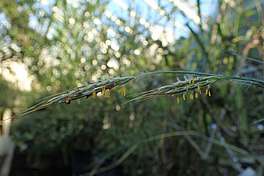Compilospecies
A compilospecies is a genetically aggressive species which acquires the heredities of a closely related sympatric species by means of hybridisation and comprehensive introgression.[1][2] The target species may be incorporated to the point of despeciation, rendering it extinct.[1] This type of genetic aggression is associated with species in newly disturbed habitats (such as pioneering species), weed species and domestication.[1] They can be diploid or polyploid, as well as sexual or primarily asexual.[1] The term compilospecies derives from the Latin word compilo, which means to seize, to collect, to rob or to plunder.[1] A proposed explanation for the existence of such a species with weak reproductive barriers and frequent introgression is that it allows for genetic variation. An increase in the gene pool through viable hybrids can facilitate new phenotypes and the colonisation of novel habitats.[3][4] The concept of compilospecies is not frequent in scientific literature and may not be fully regarded by the biological community as a true evolutionary concept, especially due to low supporting evidence.[2][5]
History

Compilospecies were first described by Harlan and de Wet in 1962, who examined a wide range of grasses and other species such as Bothriochloa intermedia, otherwise known as Australian bluestem grass. B. intermedia was found to introgress heavily with neighboring sympatric grass species and even genera, particularly in geographically restricted areas.[1] The species itself is of hybrid origin, containing genetic material from five or more different grass species.[1] Harlan and de Wet examined the interactions between the genera Bothriochloa, Dichanthium and Capillipedium - an apomictic complex of grasses from the tribe Andropogoneae - and used the cytogenetic model of these as a basis for the compilospecies concept.[1][6] Species within these genera exhibit both sexual and asexual reproduction, high heteriozygosity, ploidies from 2x to 6x, and gene flow between bordering populations as evidence of ongoing introgression.[1][6] However, this gene flow is only made possible in the presence of B. intermedia, which introgression moves towards, and the absence of which keeps the other species reproductively isolated.[1][7] B. intermedia is identified as the compilospecies in this model.
Further examples
Other researched examples of compilospecies include;
References
- Harlan, Jack R.; de Wet, J. M. J. (December 1963). "The Compilospecies Concept". Evolution. 17 (4): 497. doi:10.2307/2407101. ISSN 0014-3820. JSTOR 2407101.
- Wilkins, John S. (2018). Species : the evolution of the idea (2nd ed.). Boca Raton, FL. ISBN 9781138055742. OCLC 1013527051.
- Aguilar, Javier Fuertes; Rosselló, Josep Antoni; Feliner, Gonzalo Nieto (1999-10-01). "Molecular Evidence for the Compilospecies Model of Reticulate Evolution in Armeria (Plumbaginaceae)". Systematic Biology. 48 (4): 735–754. doi:10.1080/106351599259997. ISSN 1076-836X. PMID 12066298.
- Francisco-Ortega, J.; Jansen, R. K.; Santos-Guerra, A. (1996-04-30). "Chloroplast DNA evidence of colonization, adaptive radiation, and hybridization in the evolution of the Macaronesian flora". Proceedings of the National Academy of Sciences. 93 (9): 4085–4090. doi:10.1073/pnas.93.9.4085. ISSN 0027-8424.
- Arnold, Michael L. (1997). Natural hybridization and evolution. Oxford University Press. ISBN 0195099753. OCLC 807778434.
- Singh, Ram J. (2003). Plant cytogenetics (2nd ed.). Boca Raton, Fla.: CRC Press. ISBN 9781420038507. OCLC 122938650.
- Sambamurty, A. V. S. S. (2005). Taxonomy of Angiosperms. New Delhi: I.K. International. ISBN 8188237167. OCLC 841013792.
- Rieseberg, Loren Henry (1991). Phylogenetic consequences of cytoplasmic gene flow in plants. Evolutionary Trends in Plants. OCLC 41324795.
- Rieseberg, Loren H.; Brunsfeld, Steven J. (1992), "Molecular Evidence and Plant Introgression", Molecular Systematics of Plants, Springer US, pp. 151–176, doi:10.1007/978-1-4615-3276-7_7, ISBN 9780412022418
- Rieseberg, Loren H.; Beckstrom-Sternberg, Stephen M.; Liston, Aaron; Arias, Dulce M. (January 1991). "Phylogenetic and Systematic Inferences from Chloroplast DNA and Isozyme Variation in Helianthus sect. Helianthus (Asteraceae)". Systematic Botany. 16 (1): 50. doi:10.2307/2418973. ISSN 0363-6445. JSTOR 2418973.
- Brochmann, C. (1992). Polyploid evolution in arctic-alpine Draba (Brassicaceae). Oslo, Norway: Botanical Garden and Museum, University of Oslo. ISBN 8274200160. OCLC 27925378.